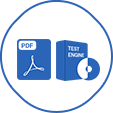Last Update 5 hours ago Total Questions : 172
The CBIC Certified Infection Control Exam content is now fully updated, with all current exam questions added 5 hours ago. Deciding to include CIC practice exam questions in your study plan goes far beyond basic test preparation.
You'll find that our CIC exam questions frequently feature detailed scenarios and practical problem-solving exercises that directly mirror industry challenges. Engaging with these CIC sample sets allows you to effectively manage your time and pace yourself, giving you the ability to finish any CBIC Certified Infection Control Exam practice test comfortably within the allotted time.
The BEST roommate selection for a patient with active shingles would be a patient who has had
A 2-yoar-old girl is admitted with a fractured tibia. At birth, she was diagnosed with congenital cytomegalovirus (CMV). Which of the following barrier precautions is appropriate for healthcare personnel caring for her?
Which of the following pathogens is associated with the highest risk of seroconversion after percutaneous exposure?
In the current year, cases of tuberculosis (TB) among foreign-born persons accounted for the majority of new TB cases in the United States. The number of states with greater than 50% of cases among foreign-born persons increased from four cases ten years ago to 22 cases in the current year. This information can BEST be used to
heighten awareness among Emergency Department staff.
inform staff who are foreign-born.
educate patients and visitors.
review the TB exposure control plan.
What rate is expressed by the number of patients who acquire infections over a specified time period divided by the population at risk of acquiring an infection during that time period?
Which of the following infectious diseases is associated with environmental fungi?
A healthcare personnel has an acute group A streptococcal throat infection. What is the earliest recommended time that this person may return to work after receiving appropriate antibiotic therapy?

